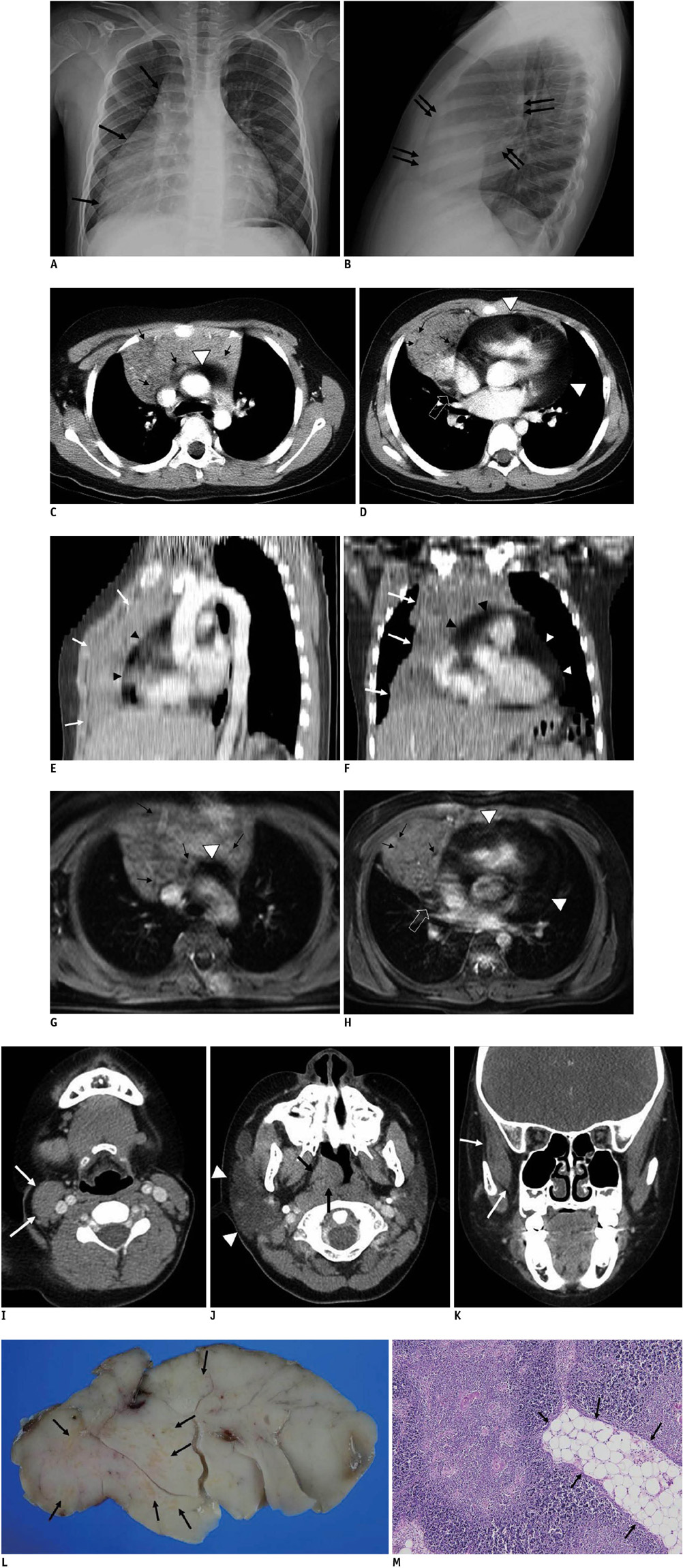Korean J Radiol.
2011 Jun;12(3):376-381. 10.3348/kjr.2011.12.3.376.
Unusual Thymic Hyperplasia Mimicking Lipomatous Tumor in an Eight-Year-Old Boy with Concomitant Pericardial Lipomatosis and Right Facial Hemihypertrophy
- Affiliations
-
- 1Department of Radiology, Seoul National University College of Medicine and the Institute of Radiation Medicine, Seoul 110-744, Korea. kimws@radcom.snu.ac.kr
- 2Department of Pathology, Seoul National University Hospital, Seoul National University College of Medicine, Seoul 110-744, Korea.
- KMID: 1122335
- DOI: http://doi.org/10.3348/kjr.2011.12.3.376
Abstract
- We report a case of thymic hyperplasia accompanied by pericardial lipomatosis and right facial hemihypertrophy in an 8-year-old boy. On imaging studies, the hyperplastic thymus had prominent curvilinear and nodular fatty areas simulating a fat-containing anterior mediastinal mass, which is an unusual finding in children. To our knowledge, this is the first report on a child with a combination of thymic hyperplasia, pericardial lipomatosis, and right facial hemihypertrophy. The radiologic findings are presented with a brief discussion.
Keyword
MeSH Terms
-
Child
Diagnosis, Differential
Facial Asymmetry/complications/*diagnosis
Heart Diseases/complications/*diagnosis/surgery
Humans
Hypertrophy/pathology
Lipomatosis/complications/*diagnosis/surgery
Magnetic Resonance Imaging
Male
Pericardium/*pathology
Thymus Hyperplasia/complications/*diagnosis/surgery
Tomography, X-Ray Computed
Figure
Reference
-
1. Thomas LS. The mediastinum, Caffey's pediatric diagnostic imaging. 2007. 11th ed. Philadelphia: Mosby Elsevier;1339–1344.2. Baron RL, Lee JK, Sagel SS, Peterson RR. Computed tomography of the normal thymus. Radiology. 1982. 142:121–125.3. Siegel MJ, Glazer HS, Wiener JI, Molina PL. Normal and abnormal thymus in childhood: MR imaging. Radiology. 1989. 172:367–371.4. Takahashi K, Inaoka T, Murakami N, Hirota H, Iwata K, Nagasawa K, et al. Characterization of the normal and hyperplastic thymus on chemical-shift MR imaging. AJR Am J Roentgenol. 2003. 180:1265–1269.5. Nishino M, Ashiku SK, Kocher ON, Thurer RL, Boiselle PM, Hatabu H. The thymus: a comprehensive review. Radiographics. 2006. 26:335–348.6. Akhtar A, D'Cruz IA, Ramanathan KB, Umpierrez M. Diffuse locally invasive lipomatosis of the pericardium. Echocardiography. 2003. 20:173–177.7. Sanal HT, Kocaoglu M, Yildirim D, Ors F. Multiple cardiac lipomas and pericardial lipomatosis: multidetector-row computer tomography findings. Int J Cardiovasc Imaging. 2007. 23:655–658.8. Thiffault I, Schwartz CE, Der Kaloustian V, Foulkes WD. Mutation analysis of the tumor suppressor PTEN and the glypican 3 (GPC3) gene in patients diagnosed with Proteus syndrome. Am J Med Genet A. 2004. 130A:123–127.9. Dalal AB, Phadke SR, Pradhan M, Sharda S. Hemihyperplasia syndromes. Indian J Pediatr. 2006. 73:609–615.10. Boybeyi O, Alanay Y, Kayikcioglu A, Karnak I. Hemihyperplasia-multiple lipomatosis syndrome: an underdiagnosed entity in children with asymmetric overgrowth. J Pediatr Surg. 2010. 45:E19–E23.


